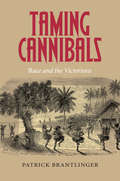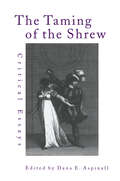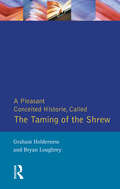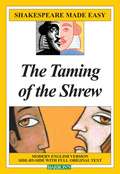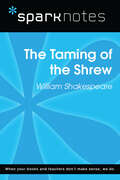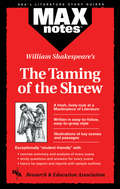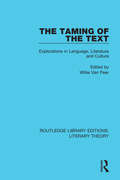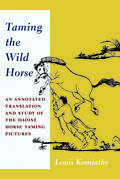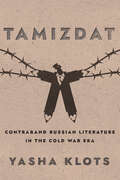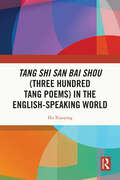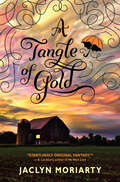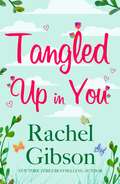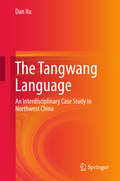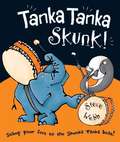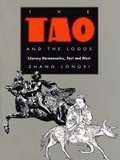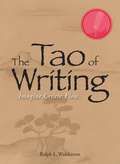- Table View
- List View
Tamil Term-1 class 7 - Tamil Nadu Board: தமிழ் ஏழாம் வகுப்பு முதல் பருவம் தொகுதி 1
by State Council of Educational Research and Training Tamil Naduஇந்தப் புத்தகத்தில் மொழி அமுதத்தமிழ், இயற்கை அணிநிழல் காடு மற்றும் நாடு அதை நாடு பற்றி நன்கு அறிந்து கொள்ளலாம்
Tamil Term-2 class 7 - Tamil Nadu Board: தமிழ் ஏழாம் வகுப்பு இரண்டாம் பருவம் தொகுதி 1
by State Council of Educational Research and Training Tamil Naduஇந்தப் புத்தகத்தில் அறிவியல், தொழில்நுட்பம், அறிவியல் ஆக்கம், கல்வி, ஓதுவது ஒழியேல், கலை அழகியல் மற்றும் கலை வண்ணம் போன்ற தலைப்புகள் குறித்து நன்கு அறிந்து கொள்ளலாம்
Tamil Term-3 class 7 - Tamil Nadu Board: தமிழ் ஏழாம் வகுப்பு மூன்றாம் பருவம் தொகுதி 1
by State Council of Educational Research and Trainingஇந்த புத்தகத்தில் ஒப்புரவு ஒழுகு, மானுடம் வெல்லும், நயந்தகு நாகரிகம் ஆகிய தலைப்புகளை குறித்து நன்கு அறிந்து கொள்ளலாம்
Taming Babel
by Rachel Leow"Taming Babel sheds new light on the role of language in the making of modern postcolonial Asian nations. Focusing on one of the most linguistically diverse territories in the British Empire, Rachel Leow explores the profound anxieties generated by a century of struggles to govern the polyglot subjects of British Malaya and postcolonial Malaysia. The book ranges across a series of key moments in the nineteenth and twentieth centuries, in which British and Asian actors wrought quiet battles in the realm of language: in textbooks and language classrooms; in dictionaries, grammars and orthographies; in propaganda and psychological warfare; and in the very planning of language itself. Every attempt to tame Chinese and Malay languages resulted in failures of translation, competence, and governance, exposing both the deep fragility of a monoglot state in polyglot milieux, and the essential untameable nature of languages in motion"--
Taming Cannibals: Race and the Victorians
by Patrick BrantlingerIn Taming Cannibals, Patrick Brantlinger unravels contradictions embedded in the racist and imperialist ideology of the British Empire. For many Victorians, the idea of taming cannibals or civilizing savages was oxymoronic: civilization was a goal that the nonwhite peoples of the world could not attain or, at best, could only approximate, yet the "civilizing mission" was viewed as the ultimate justification for imperialism. Similarly, the supposedly unshakeable certainty of Anglo-Saxon racial superiority was routinely undercut by widespread fears about racial degeneration through contact with "lesser" races or concerns that Anglo-Saxons might be superseded by something superior—an even "fitter" or "higher" race or species. Brantlinger traces the development of those fears through close readings of a wide range of texts—including Robinson Crusoe by Daniel Defoe, Fiji and the Fijians by Thomas Williams, Daily Life and Origin of the Tasmanians by James Bonwick, The Descent of Man by Charles Darwin, Heart of Darkness by Joseph Conrad, Culture and Anarchy by Matthew Arnold, She by H. Rider Haggard, and The War of the Worlds by H. G. Wells. Throughout the wide-ranging, capacious, and rich Taming Cannibals, Brantlinger combines the study of literature with sociopolitical history and postcolonial theory in novel ways.
The Taming of the Shrew: Critical Essays (Shakespeare Criticism)
by Dana E. AspinallThis volume is a comprehensive collection of critical essays on The Taming of the Shrew, and includes extensive discussions of the play's various printed versions and its theatrical productions. Aspinall has included only those essays that offer the most influential and controversial arguments surrounding the play. The issues discussed include gender, authority, female autonomy and unruliness, courtship and marriage, language and speech, and performance and theatricality.
Taming of the Shrew: First Quarto of "Taming of a Shrew" (Shakespearean Originals--first Editions Ser.)
by Graham Holderness Bryan LoughreyFirst Published in 1992. This series puts into circulation single annotated editions of early modern play-texts whose literary and theatrical histories have been overshadowed by editorial practices dominant since the eighteenth century. The text contained in this volume is not what we know as Shakespeare's The Taming of the Shrew, modern editions of which play are all derived from the text printed in the 1623 First Folio edition of Shakespeare's works. The present text is an edition of the play published in 1594 under the title The Taming of a Shrew, which has always been denied the authorising signature of 'Shakespeare', and regarded as an earlier version by another dramatist or as a pirated and corrupt 'memorial reconstruction' of Shakespeare's The Taming of the Shrew.
Taming of the Shrew (Shakespeare Made Easy)
by William ShakespeareA Simon & Schuster eBook. Simon & Schuster has a great book for every reader.
The Taming of the Shrew (SparkNotes Literature Guide Series)
by SparkNotesThe Taming of the Shrew (SparkNotes Literature Guide) by William Shakespeare Making the reading experience fun! Created by Harvard students for students everywhere, SparkNotes is a new breed of study guide: smarter, better, faster. Geared to what today's students need to know, SparkNotes provides: *Chapter-by-chapter analysis *Explanations of key themes, motifs, and symbols *A review quiz and essay topicsLively and accessible, these guides are perfect for late-night studying and writing papers
Taming of the Shrew, The (MAXnotes Literature Guides)
by Christopher GarcezREA's MAXnotes for William Shakespeare's The Taming of the Shrew The MAXnotes offers a comprehensive summary and analysis of The Taming of the Shrew and a biography of William Shakespeare. Places the events of the play in historical context and discusses each act in detail. Includes study questions and answers along with topics for papers and sample outlines.
The Taming of the Text: Explorations in Language, Literature and Culture (Routledge Library Editions: Literary Theory #19)
by Willie Van PeerThe contributors of this text, first published in 1988, provide a dynamic view of the social functioning of texts, taking account of linguistic, literary and cultural elements. They bring together innovative perspectives on literary analysis and theory, on pragmatics and discourse analysis, as well as on text linguistics and reception theory. Various text types are examined, and the editor introduces each chapter in order to draw them all together to make a fascinating and cohesive whole.
The Taming of the Text: Explorations in Language, Literature and Culture (Routledge Library Editions: Literary Theory)
by Willie Van PeerThe contributors of this text, first published in 1988, provide a dynamic view of the social functioning of texts, taking account of linguistic, literary and cultural elements. They bring together innovative perspectives on literary analysis and theory, on pragmatics and discourse analysis, as well as on text linguistics and reception theory. Various text types are examined, and the editor introduces each chapter in order to draw them all together to make a fascinating and cohesive whole.
Taming the Corpus: From Inflection and Lexis to Interpretation (Quantitative Methods in the Humanities and Social Sciences)
by Masako Fidler Václav CvrčekThis book bridges the current quantitative and qualitative text analyses, using grammar as a crucial source of investigation. Taking data from Czech, an inflected language, in which the most optimal conditions to respond to this research question are met, the book expands the understanding of language and text in ways that have not been executed before. For predominantly English-based quantitative research, this volume fills a crucial gap by examining the relationship between inflection and other phenomena (including discourse, translation and literature). For the current qualitative research, the volume provides large empirical data to confirm some of its claims, but more importantly, it demonstrates the important role of detailed grammatical concepts that have not been considered before. Besides addressing fundamental questions about text analysis methods, the volume presents a diverse array of Czech data that are unique in their own right and worthy of dissemination to the general audience. Taming the Corpus: From Inflection and Lexis to Interpretation is divided into three sections. Section 1 deals with phonotactics, poetic structure, morphological complexity used to differentiate literary style, and native speakers’ sense of grammaticality – issues pertinent to linguistic typology, cognition and language, and literary studies. Section 2 focuses on inter-language relations, especially the theory of translation. Section 3 demonstrates how quantitative analysis of texts can contribute to our understanding of society and connects the volume to legal language, construction of gender and discourse position and implicit ideology.
Taming the Vernacular: From dialect to written standard language
by Jenny Cheshire Dieter SteinTaming the Vernacular: From Dialect to Written Standard Language examines the differences between 'standard' and 'nonstandard' varieties of several different languages. Not only are some of the best-known languages of Europe represented here, but also some that have been less well-researched in the past. The chapters address the syntax of Dutch, English, French, Finnish, Galician, German and Spanish. For these languages, and many others, it is the standard varieties on which the most extensive syntactic research has been carried out, with the result that very little is known about the syntax of their dialects or the spoken colloquial varieties. The editors of this volume seek to redress the balance by taking a cross-linguistic perspective on the historical development of the standardised varieties. This allows them to identify some common characteristics of spoken language. It also helps the reader to understand the kinds of filtering processes that are involved in standardization, which result in the syntax of spoken colloquial language being different from the syntax of the standard varieties.Taming the Vernacular: From Dialect to Written Standard Language is suitable for undergraduate and postgraduate students of Linguistics, particularly those taking courses in sociolinguistics, dialectology, and historical linguistics. The focus on a variety of languages also makes this text suitable for students studying courses which cover the linguistic aspects of European languages.
Taming the Wild Horse: An Annotated Translation and Study of the Daoist Horse Taming Pictures
by Louis KomjathyIn thirteenth-century China, a Daoist monk named Gao Daokuan (1195-1277) composed a series of illustrated poems and accompanying verse commentary known as the Daoist Horse Taming Pictures. In this annotated translation and study, Louis Komjathy argues that this virtually unknown text offers unique insights into the transformative effects of Daoist contemplative practice. Taming the Wild Horse examines Gao's illustrated poems in terms of monasticism and contemplative practice, as well as the multivalent meaning of the "horse" in traditional Chinese culture and the consequences for both human and nonhuman animals.The Horse Taming Pictures consist of twelve poems, ten of which are equine-centered. They develop the metaphor of a "wild" or "untamed" horse to represent ordinary consciousness, which must be reined in and harnessed through sustained self-cultivation, especially meditation. The compositions describe stages on the Daoist contemplative path. Komjathy provides opportunities for reflection on contemplative practice in general and Daoist meditation in particular, which may lead to a transpersonal way of perceiving and being.
Tamizdat: Contraband Russian Literature in the Cold War Era (NIU Series in Slavic, East European, and Eurasian Studies #86)
by Yasha Yakov KlotsTamizdat offers a new perspective on the history of the Cold War by exploring the story of the contraband manuscripts sent from the USSR to the West. A word that means publishing "over there," tamizdat manuscripts were rejected, censored, or never submitted for publication in the Soviet Union and were smuggled through various channels and printed outside the country, with or without their authors' knowledge. Yasha Klots demonstrates how tamizdat contributed to the formation of the twentieth-century Russian literary canon: the majority of contemporary Russian classics first appeared abroad long before they saw publication in Russia.Examining narratives of Stalinism and the Gulag, Klots focuses on contraband manuscripts in the 1960s and 70s, from Khrushchev's Thaw to Stagnation under Brezhnev. Klots revisits the traditional notion of late Soviet culture as a binary opposition between the underground and official state publishing. He shows that even as tamizdat represented an alternative field of cultural production in opposition to the Soviet regime and the dogma of Socialist Realism, it was not devoid of its own hierarchy, ideological agenda, and even censorship. Tamizdat is a cultural history of Russian literature outside the Iron Curtain. The Russian literary diaspora was the indispensable ecosystem for these works. Yet in the post-Stalin years, they also served as a powerful weapon on the cultural fronts of the Cold War, laying bare the geographical, stylistic, and ideological rifts between two disparate yet inextricably intertwined fields of Russian literature, one at home, the other abroad.Open Access edition funded by the National Endowment for the Humanities.
Tang Shi San Bai Shou (Three Hundred Tang Poems) in the English-Speaking World
by Hu XiaoyingThis book examines six English translations of Tang Shi San Bai Shou (Three Hundred Tang Poems), the renowned anthology of Tang poetry, and explores the challenges and strategies involved in conveying the essence of classical Chinese poetry to an English-speaking audience.As a classic anthology, Tang Shi San Bai Shou captures the linguistic features, unique expressions and traditional culture of ancient Chinese verse. Since its publication in the Qing dynasty, it has circulated widely in China and extended its influence to the English-speaking world, with a rich history of translation and dissemination. This book unravels the complexities of translating classical Chinese poetry and highlights the different approaches taken by translators of different periods and backgrounds by comparing six complete translations. The book discusses the linguistic, cultural and artistic characteristics of Tang poetry, and readers can see how these challenges and the gaps between ancient Chinese poetry and modern English audiences are bridged by the ongoing efforts of translators.Scholars and students of classical Chinese literature and translation studies, as well as Chinese-English translators and Chinese poetry enthusiasts, will find this book a useful reference. Readers interested in Chinese culture will be led into the poetic world of ancient China.
A Tangle of Gold: Book 3 Of The Colors Of Madeleine (The Colors of Madeleine #3)
by Jaclyn Moriarty“A grand finale to a grand adventure, complete with truly startling revelations . . . Colorful and madcap . . . deeply satisfying, perfectly ended.” —Kirkus Reviews (starred review)Cello is in crisis. Princess Ko’s deception of her people has emerged and the Kingdom is outraged; the Jagged Edge Elite have taken control, placing the Princess and two members of the Royal Youth Alliance under arrest and ordering their execution; the King’s attempts to negotiate their release have failed; Color storms are rampant; and nobody has heard the Cello wind blowing in months. Meanwhile, Madeleine fears she’s about to lose the Kingdom of Cello forever. Plans are in place to bring the remaining Royals home, and after that, all communication between Cello and the World will cease. That means she’ll also lose Elliot, now back in Cello and being held captive by a branch of Hostiles. And there’s nothing he can do to help his friends unless he can escape the Hostile compound.Worlds apart and with time running out, Madeleine and Elliot find themselves on a collision course to save the Kingdom they love, and maybe even save each other.“A breathless and exhilarating race to the finish . . . with a variety of unexpected revelations and marvelous surprises, and with [Moriarty’s] usual perfect timing.” —The Horn Book (starred review)“The magic continues to be refreshingly inventive, and the world-building is so precise . . . This final installment will garner even more followers.” —School Library Journal (starred review)“Startling and clever . . . A breathtaking climax . . . An eminently satisfying conclusion.” —The Bulletin of the Center for Children’s Books (starred review)
Tangled Up In You: A fabulously funny rom-com (Writer Friends)
by Rachel GibsonTangled Up In You is a fabulously funny rom-com from New York Times bestseller Rachel Gibson - perfect for fans of Jill Shalvis, Jo Watson and Christina Lauren.When Maddie Dupree enters Hennessy's Bar in Truly, Idaho, she isn't looking for a husband, a boyfriend, or even just a drink. She's looking for the truth about her past, and nothing will stand in her way. Especially not a Hennessy boy. Everyone knows Mick Hennessy is irresistible. So far, he's managed to keep the ladies in line, but when he claps eyes on gorgeous Maddie, he just can't help getting involved. But Maddie's keeping secrets about why she's in town - and when those secrets are revealed, there'll be a whole lot of trouble in Truly...Check out the rest of Rachel's addictive titles, including Sex, Lies and Online Dating, I'm In No Mood For Love and Not Another Bad Date.
The Tangwang Language
by Dan XuThis book studies the Tangwang language, providing the first comprehensive grammar in English of this Chinese variety, with detailed analysis of its phonology, morphology, and syntax. This fills a gap in the literature, as previously only a few articles on this language were available. The book takes an interdisciplinary approach, examining genetic data to determine historical patterns of population migration, as well as linguistic data that focus on the influence of the Dongxiang (Santa) language as a consequence of language contact on the Silk Road. The concluding chapter argues that Tangwang has not yet become a mixed language, and that syntactic borrowing has a stronger impact than lexical borrowing on languages.
Tanka Tanka Skunk
by Steve WebbRhyming has never been so much fun as in Steve Webb's bold, new picture book, which encourages children to read aloud, following the easy and catchy rhythm of the text. "Skunka Tanka Skunka Tanka Tanka Tanka Skunk! They've got the beat, and so do their friends." "Meet Tanka and his friend, Skunk. When you say their names together, they sound like drums!" Steve Webb's innovative and visually stunning picture book introduces young readers to simple rhythms with this riot of shout-out-loud words and cavorting animals. TANKA TANKA SKUNK! makes reading tons of fun as the text and the illustrations leap and dance across the pages.
The Tao and the Logos: Literary Hermeneutics, East and West
by Longxi ZhangQuestions of the nature of understanding and interpretation--hermeneutics--are fundamental in human life, though historically Westerners have tended to consider these questions within a purely Western context. In this comparative study, Zhang Longxi investigates the metaphorical nature of poetic language, highlighting the central figures of reality and meaning in both Eastern and Western thought: the Tao and the Logos. The author develops a powerful cross-cultural and interdisciplinary hermeneutic analysis that relates individual works of literature not only to their respective cultures, but to a combined worldview where East meets West. Zhang's book brings together philosophy and literature, theory and practical criticism, the Western and the non-Western in defining common ground on which East and West may come to a mutual understanding. He provides commentary on the rich traditions of poetry and poetics in ancient China; equally illuminating are Zhang's astute analyses of Western poets such as Rilke, Shakespeare, and Mallarmé and his critical engagement with the work of Foucault, Derrida, and de Man, among others. Wide-ranging and learned, this definitive work in East-West comparative poetics and the hermeneutic tradition will be of interest to specialists in comparative literature, philosophy, literary theory, poetry and poetics, and Chinese literature and history.
The Tao of Pooh
by Benjamin HoffThe how of Pooh? The Tao of who? The Tao of Pooh!?! In which it is revealed that one of the world's great Taoist masters isn't Chinese--or a venerable philosopher--but is in fact none other that that effortlessly calm, still, reflective bear. A. A. Milne's Winnie-the-Pooh!While Eeyore frets, and Piglet hesitates, and Rabbit calculates, and Owl pontificates, Pooh just is.<P> And that's a clue to the secret wisdom of the Taoists.
The Tao Of Writing
by Ralph L. WahlstromThe creative process doesn't have to be torturous--with The Tao of Writing, it can be glorious! Invoking the principles of the Tao allows you to do your best work ever. By tapping into the true flow of your creativity, you can discover and develop your true talents and abilities. Author Ralph Wahlstrom uses the connection between teaching, writing, and the tenets of the Tao to help you learn to write from a new perspective, enhancing your work and your creative journey. With The Tao of Writing as your guide, you can overcome "writer's rigor mortis," and become a better, happier, more productive writer.
The Tao Of Writing: Imagine. Create. Flow.
by Ralph L WahlstromA Simon & Schuster eBook. Simon & Schuster has a great book for every reader.

